Month: July 2014
Whale poop may help fight climate change

By John Metcalfe, Cross-posted from CityLab, Source: Grist
It’s not a good time to be living in the ocean. Aside from oil spills and the scourge of plastics pollution, the seas are becoming ever more acidic due to humanity’s CO2 flooding the atmosphere. The altered PH of the water makes for a bevy of problems, from making fish act in really weird ways to dissolving the shells of creatures critical to the marine food chain.
But a group of scientists from the University of Vermont and elsewhere think the ocean’s future health has one thing going for it: the restoration of whale populations. They believe that having more whales in the water creates a more stable marine environment, partly through something called a “whale pump” — a polite term for how these majestic animals defecate.
Commercial hunting of great whales, meaning the baleen and sperm variety, led to a decline in their numbers as high as 66 percent to 90 percent, the scientists write in a new study in Frontiers in Ecology and the Environment. This mammalian decimation “likely altered the structure and function of the oceans,” says lead author Joe Roman, “but recovery is possible and in many cases is already under way.”
The researchers — who are whale biologists — present a couple of arguments for how these animals help secure the climate-threatened ocean. The first is their bathroom behavior: After feeding on krill in the briny deep, whales head back to the surface to take massive No. 2s. You can see the “pumping” process in action amid this group of sperm whales off the coast of Sri Lanka:

You have to feel for the person who took that photo. But these “flocculent fecal plumes” happen to be laden with nutrients and are widely consumed by plankton, which in turn takes away carbon from the atmosphere when they photosynthesize, die, and wind up on the ocean floor. A previous study of the Southern Ocean, to cite just one example, indicated that sperm-whale defecation might remove hundreds of thousands of tons of atmospheric carbon each year by enhancing such plankton growth. Thus, these large whales “may help to buffer marine ecosystems from destabilizing stresses” like warmer temperatures and acidification, the researchers claim.
The other nice thing whales do for the climate is eat tons of food and then die. In life, they are fantastic predators. But in death, their swollen bodies are huge sarcophagi for carbon. When the Grim Reaper comes calling, whales sink and sequester lots and lots of carbon at the bottom of the sea, like this dearly departed fellow:

While there’s no exact measurement of how these “whale falls” impact global carbon sequestration — and some argue it can’t have that big of an effect — Roman thinks it’s worth keeping in mind when thinking about protecting these vulnerable creatures. As he told an Alaskan news station last year, “This may be a way of mitigating climate change, if we can restore whale populations throughout the world.”
This story was produced by The Atlantic’s CityLab as part of the Climate Desk collaboration.
Canadians are eating tar-sands pollution

By John Upton, Grist
Tar-sands extraction isn’t just turning swaths of Canadian land into postapocalyptic film sets. New research shows it’s also contaminating the wild animals that members of the Mikisew Cree and Athabasca Chipewyan First Nations have traditionally relied on for food.
We already knew that the tar-sands operations have been dousing northern Alberta with mercury and other forms of pollution. Now university scientists have collaborated with the First Nations to test the pollution levels in hunted animals found downstream from the tar-sands sites. Here are some lowlights from their findings, which were included in a report published on Monday:
Arsenic levels were high enough in in muskrat and moose muscle; duck, moose, and muskrat livers; and moose and duck kidneys to be of concern for young children. Cadmium levels were again elevated in moose kidney and liver samples but also those of beaver and ducks … Mercury levels were also high for duck muscle, kidneys, and livers as well as moose and muskrat kidneys, especially for children. …
Total levels of PAHs [polycyclic aromatic hydrocarbons] and levels of carcinogenic and alkylated PAHs were very high relative to other food studies conducted around the world.
The First Nations members aren’t shocked to hear this. Some have already started avoiding their traditional foods because of worries about contamination, they told researchers. More from the report:
Participants were concerned about declines in the quality of [traditional] foods, in the greatest part because of environmental pollutants originating from the Oil Sands. It was notable how many participants no longer consumed locally caught fish, because of government-issued consumption advisories and associated human health concerns. Muskrat consumption had also declined precipitously, along with muskrat populations, a decline that was attributed to changes in hydrology and contaminant levels associated with the WAC Bennett Dam and the Oil Sands. The only effective alternatives to traditional foods are store-bought foods. …
All participants were worried about ongoing declines in the health and wellbeing of their community. They generally viewed themselves as less healthy than their parents, who rarely got sick. Neurological illnesses (e.g. sleeping disorders, migraines, and stress) were most common followed, in descending order of frequency, by respiratory illnesses (e.g. allergies, asthma) as well as circulatory (e.g. hypertension, coronary) and gastrointestinal (e.g. gallbladder, ulcers) illnesses. Yet, everyone was most concerned about the current and escalating cancer crisis.
A documentary about the research — One River, Many Relations — will be released in October. Here’s a trailer:
Alaska From Scratch: Crusted salmon with a kick
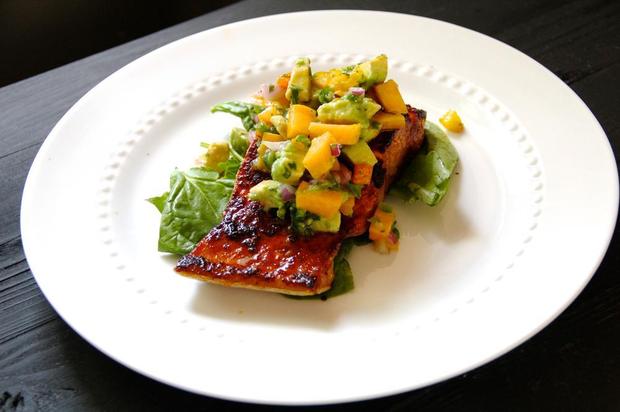
MAYA EVOY
By Maya Evoy
Alaska From Scratch July 4, 2014
There is nothing more seasonal in Alaska in July than a wild salmon caught directly from our local shores.
One evening last summer, after 13 hours on the water, a friend of ours came home with a marvelous salmon. Although it was late, it was still light out, and he and my husband made quick work of filleting while I pulled up a recipe. It wasn’t long before the fish was sizzling in a hot pan, filling the house with the aroma of spices and saltwater mingling together. There is truly nothing better.
That night, I coated the salmon with a homemade spice rub, based on a recipe I found on my talented friend Heidi Drygas’ local food blog, Chena Girl Cooks. Together, we ooh’ed and ahh’ed over the smokiness of the paprika and the cumin, the kick of the chili powder and dry mustard, the nice sweetness from the sugar and a surprising pinch of cinnamon. And can we just talk about that beautiful charred crust for a moment? You get a stunning caramelization when a hot pan swirled with oil meets a perfectly fresh fillet of salmon, patted dry (this is key) and rubbed generously. “I have to write about this,” I said aloud between bites, squeezing a wedge of lime over my fillet before diving back in. “We have to make this again.”
Two nights later, we indeed made it all over again, and this time I made a bright, summery avocado-peach salsa to go with it. When I don’t have peaches on hand, I’ve used mangoes in the salsa with equally terrific results. Since last summer, we have looked forward to eating this dish again, as soon as the first fresh salmon comes through the door and into my kitchen.
Sugar-crusted salmon with avocado-peach salsa
For the salsa:
- 2 sweet but firm peaches, pitted and finely chopped (or mangoes)
- 2 ripe avocados, finely chopped
- 1 small red or orange bell pepper, finely chopped
- 1/2 cup red onion, diced
- 1-2 jalapenos (to taste), seeds removed and minced
- 1/2 cup cilantro leaves, chopped
- 1 lime, juiced
- salt and pepper, to taste
For the salmon:
- 2 tablespoons sugar
- 1 tablespoon chili powder
- 11/2 teaspoons smoked paprika
- 1 1/2 teaspoons ground cumin
- 1/4 teaspoon dry mustard
- pinch of cinnamon
- 1 teaspoon freshly ground black pepper
- 11/2 teaspoons kosher salt
- 4-6 wild-caught salmon fillets (about 4-6 ounces each), pin bones and skin removed
- 2 tablespoons olive oil
In a bowl, gently stir together the peaches, avocados, bell peppers, onion, jalapeno, cilantro and lime. Season with salt and pepper to taste. Cover and refrigerate until ready to serve.
In a smaller bowl, stir together the sugar, chili powder, paprika, cumin, mustard, cinnamon, pepper and salt.
Heat the olive oil in a skillet over medium-high heat. Pat the salmon fillets dry and liberally season the top of each fillet with the rub, patting it so it will adhere. Place the fillets, seasoned side down, into the hot pan. Cook about two minutes, until rub is fragrant and caramelized but not burnt. Flip each fillet and continue to cook on the other side 2-6 minutes more, being careful not to overcook (cooking time will depend on the thickness of your fillets and your preferred doneness. I like my wild salmon fillets medium in the center, so mine were ready after four minutes). Plate the salmon and top with the avocado peach salsa. Spice rub adapted from Chena Girl Cooks, originally adapted from Alaska Seafood Marketing Institute.
Maya Evoy lives in Nikiski and blogs about food at alaskafromscratch.com.
Lushootseed Camp begins July 21

Photo courtesy of Tulalip Lushootseed Language Department
By Brandi N. Montreuil, Tulalip News
TULALIP – The Tulalip Lushootseed Language Camp will begin July 21, marking its 19th consecutive year of connecting Tulalip youth, ages 5-12, to the Lushootseed language and Tulalip culture.
This year youth will learn the traditional Tulalip story, “Seal Hunting Brothers,” told by Martha LaMont. Through the use of activity stations that include art, weaving, technology, traditional teachings, songs, and games among others, youth will learn the traditional story in Lushootseed. Youth will then perform the story in a play for the community at the end of the weeklong camp.
“This story is passed down from Martha LaMont and is one of our vision, mission and values story. Each year we pick our theme and pick our story. We ask ourselves, what story do we want them to learn; what morals do we want them to learn?” said Tulalip Luhootseed teacher Natosha Gobin, who has been teaching at the camp for over a decade.
The story, “The Seal Hunting Brothers,” explores topics about greed, honesty, providing for family and community, as well as explaining how the killer whale became the Tulalip Tribes emblem.

This year, teachers from the Quil Ceda & Tulalip Elementary School will be joining the camp in a collaborative effort to continue building a trust relationship between Marysville School District teachers and Tulalip youth.
“We’ve been doing this for 19 years, and I have been helping to lead the camp since 2003. After this many years, it is hard to hold back on all the ideas that we want to do. This year in our art station we will be teaching about Southern Coast Salish art. Kids will be able to start learning about the art design elements and how to put those elements together, while learning about positive and negative space,” said Gobin.
Held at the Tulalip Kenny Moses Building, the interactive camp is held in two sessions and open to 100 youth. Registration is open until July 28. Both camp sessions will feature a play based on the “The Seal Hunting Brothers,” held at the Hibulb Cultural Center’s Longhouse, followed by a potlatch and a traditional honoring of community members.
For more information about camp times and registration please contact the Tulalip Lushootseed Department at 360-716-4499 or visit their website at www.tulaliplushootseed.com.
Brandi N. Montreuil: 360-913-5402; bmontreuil@tulalipnews.com
24/7 Pow wow and native music online radio stations
Monica Brown, Tulalip News writer
In case you have been looking for  some native beats to enjoy, visit the links below. Both stations play 24/7 and can be listened to on either a PC or on your smart phone (there’s an app).
some native beats to enjoy, visit the links below. Both stations play 24/7 and can be listened to on either a PC or on your smart phone (there’s an app).
Pow Wow Radio – Your source for 24/7 Pow Wow music free!
http://www.powwows.com/2012/08/03/pow-wow-radio-247-native-american-pow-wow-music/
NativeMusicRadio.com – Your source for ALL types of Native American music – jazz, rock, rap, country and more!
http://www.powwows.com/2012/02/16/native-music-radio/
Also, check out the PowWows.com free mobile app and access latest information right on your iPhone, iPad, or Android device.
The app includes access to
- Latest Articles
- Pow Wow Photos
- Pow Wow Videos
- News
- Pow Wow Calendar
- Classifieds
- And more!
http://www.powwows.com/2013/08/03/new-powwows-com-app-for-android-and-ios/
All information from powwows.com
Who Wants Frybread?
Doe’z Onda Go is serving up a modern Native American classic
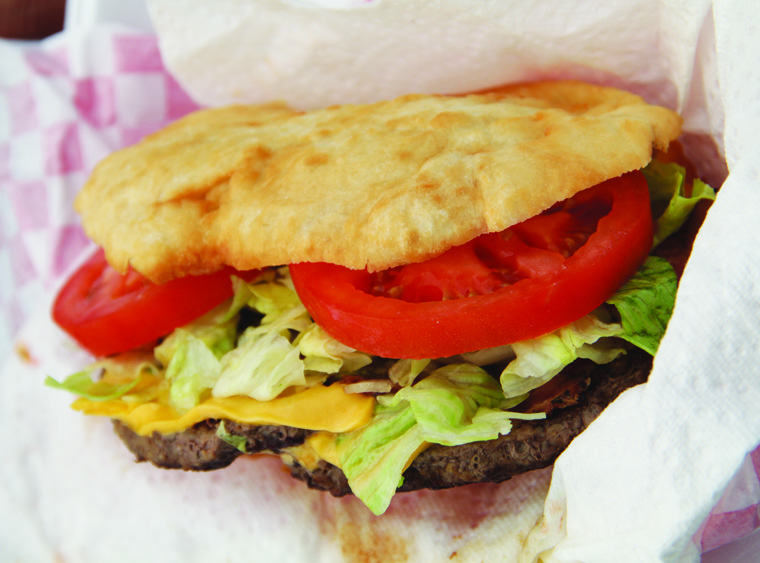
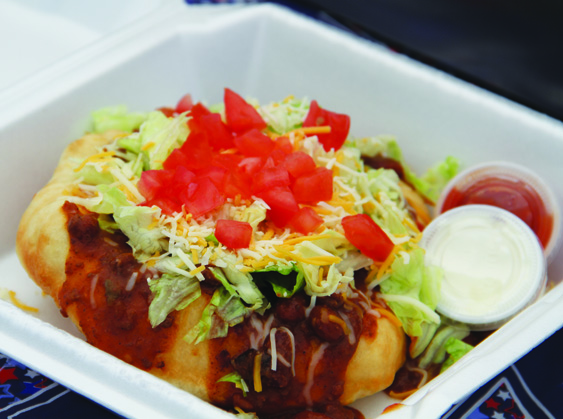
By Niki Cleary, Tulalip News
Boom City is over and you’re in between pow wows, what are you missing? Okay, besides all those opportunities for snagging. Frybread, of course! Don’t despair, you can still get your fix of that delicious, fluffy, awesomeness. Doe’z Onda Go serves frybread delicacies including Frybread burgers, Rez dogs, NLBs (Natives love bacon), and fried Oreos (Oreos wrapped in frybread), as well as the always classy frybread a la carte (which is a fancy French phrase that basically means ‘by itself’).
“Doe” is actually Nadene Foster (Klamath), also known by her nickname, Grandma DeeDee. Her frybread is made using a biscuit recipe that has been in her family for four generations, tweaked slightly to fry up crisp and light (in texture, not calories mind you).
According to Nadene, it’s not the ingredients that make her frybread special.
“It’s all made with love,” she said. “We pray every morning before we get started. We’re going to continue to produce awesome food.”
For Nadene, frybread is family tradition.
“When I moved to Southern Oregon I’d sell my bread to make a little extra money. I was always on the go. When I start making bread, all my granddaughters want to get their hands in that dough and fry their own piece!” she laughed, “They all take turns, even the boys, they all want to make their own piece.
“To go from that to where we are today is a dream come true,” said Nadene, her eyes sparkling. “It’s so exciting, I can hardly contain myself.”
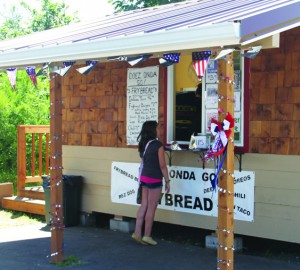
Photo/Niki Cleary
The magic all happens in a tiny building, located in the same lot as Off-Road Espresso on the corner of Marine Drive and 27th Avenue. Although the building is only About 140 square feet, it contains a full professional kitchen, including a griddle, deep fryer and a fire suppression system in case all that hot food gets out of hand.
Although the recipe is old, the business uses modern technology to make sure that orders are correct, and it’s easy to pay whether you’re using cash or a card. Orders, taken on an iPad, are quickly transformed into delicious meals.
Nadene and her business partner Eric Cortez (Tulalip), opened the business June 21st.
“This has always been a dream of Nadene’s. She showed me how to make the bread, and they had talked about going full-time,” said Eric. “I became part of the family, and I had the resources and funding to make it happen.
“My mom had the space, this empty building and the spot. By the taco stand (Tacos El Ray), Off-Road Espresso and the fruit stand. Plus this is 100% authentic, modern Native American food. Tulalip owned with a twist of southern Oregon.”
The staff favorites?
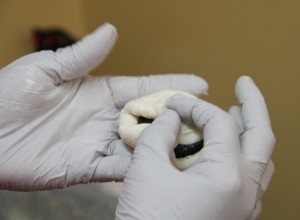
Photo/Niki Cleary
“Fried Oreos are popular,” said Eric. “I like just the frybread alone and the large Rez dog is my second favorite. We’re thinking about adding deep fried bananas as a dessert. I tried one of those and wow!”
“My favorite is probably just a piece of frybread with butter,” said Nadene. “But I also like the frybread burger.”
So, if you’re ready to fulfill your frybread fantasies, Doe’z Onda Go is the stop for you. Doe’z Onda Go is open Tusday through Saturday from 11:00 a.m. to 7:00 p.m. Short on time? Call in an order for quicker pick-up, 425-622-6289.
US Interior Dept. poised to let West Valley casino move forward
By Mike Sunnucks, Phoenix Business Journal
A controversial casino development in the West Valley is taking a big step forward.
The U.S. Department of the Interior is notifying Arizona lawmakers and other Native American communities that it is looking favorably on an effort by the Tohono O’odham Nation to take a parcel of land at 91st and Northern avenues into trust. The Southern Arizona tribe wants to develop a $500 million casino on the parcel.
This move sets the stage for full federal approval, according to an official familiar with the casino plans.
“The handwriting is on the wall,” the official said.
U.S. Department of the Interior Assistant Secretary of Indian Affairs Kevin Washburn told other tribes of his decision to approve the O’odham’s application for the land to be an extended part of their reservation.
This would propel the casino toward construction after a prolonged legal fight.
“Today’s ruling by the Department of the Interior allows the Nation to move another step closer to benefiting from the United States’ promise to the Nation that we would be able to replace our destroyed reservation lands. The Nation is eager to move forward to use our replacement land to create thousands of new jobs in the West Valley,” Tohono O’odham Nation Chairman Ned Norris, Jr. said in s statement.
The O’odham casino has faced opposition — including lawsuits and legal appeals — from some state lawmakers as well as the Salt River Pima-Maricopa Indian Community and the Gila River Indian Community. Those two tribes, which already operate casinos in the Phoenix area, cite concerns about the O’odham casino’s impact on state gaming compacts.
A federal 1986 law allows the O’odham to replace lands lost to a federal dam built in Southern Arizona with unincorporated parcels in the Phoenix area. The tribe quietly bought the West Valley parcel in 2003.
The O’odham have prevailed in lawsuits brought against the project, and efforts by U.S. Rep. Trent Franks to change the 1986 law have not progressed in Congress.
Officials involved in the casino scrap were still trying to figure out the implications of the federal actions today.
Interior officials and some Arizona players involved in the issue either could not be reached or declined requests for comment.
Salt River Pima Maricopa Indian Community President Diane Enos voiced disappointment with the ruling.
““The Community absolutely disagrees with Washburn’s decision for both legal and policy reasons. The Tohono O’odham Nation has asserted a right to create three additional Indian
reservations on county islands in Maricopa County to locate casinos. This is why many Valley mayors have been standing by tribes in asking for a resolution by Congress, fearful that their
city is next,” Enos said.
Gila River Indian Community Governor Gregory Mendoza released the following statement Friday:
“While our Community is disappointed by today’s decision, we are not surprised. As Assistant Secretary Washburn noted, he was faced with interpreting an ambiguous provision of a law passed by Congress decades ago. That’s precisely why our Community believes Congress is the best entity to decide this matter and uphold the will of Arizona’s voters. We hope voters across the state will contact their members of Congress to weigh in on this matter.
“It’s also critically important to note that this decision does not give the Tohono O’Odham Nation permission to game on this land. The Department of Interior has yet to decide that point and the majority of tribes in Arizona – including non-gaming tribes – remain opposed to the Nation’s casino because it poses a direct threat to the balance of tribal gaming in our state.
“We will review this decision thoroughly in the coming days and decide whether to take legal action.”
Brad Pitt’s Make It Right to build houses for Native Americans, website reports
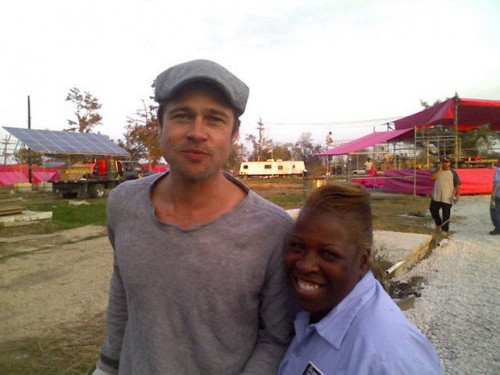
By Doug MacCash, The Times-Picayune
Brad Pitt’s Make It Right Foundation is partnering with two Native American tribes in Fort Peck, Mont., to build affordable, high design housing, the website beforeitsnews.com reported Wednesday.
According to the report:
“Brad Pitt has been partnering with Fort Peck, MT’s Sioux and Assiniboine nation tribes to build 20 super green homes for residents whose income levels are at or below 60 percent the area’s mean income, with a percentage of the homes reserved for seniors and disabled veterans.”
The Make It Right website defines the existing situation in Fort Peck in these terms:
For architecture fans, the Montana development offers the opportunity to see Make It Right-style homes designed for a cooler, more arid prairie environment.
Pitt’s Make It Right began as an altruistic effort to rebuild one of the most flood-ruined neighborhoods of New Orleans. Since 2008 a part of the Lower 9th Ward near the Claiborne Avenue Bridge has blossomed with 100 new homes.
In recent years, Pitt’s organization has taken on somewhat similar projects in Kansas City, Missouri, and Trenton, New Jersey. As of June, there was only one Make It Right home under construction in New Orleans.
Watch Pitt discuss his vision for Make It Right in Kansas City in the video below.
Human Zoo: The Story of Calafate
The Indigenous Peoples were caught and dragged before a European audience who eagerly paid to see the caged “savages”. Among them was Calafate, a 9-year old Selknam boy. They were photographed and their bodies measured; their limbs sought out by scientists. Some of them got sick, others died and others still were victims of sexual abuse.
The sordid “exhibitions” were carried out in several prominent areas including the Eiffel Tower and Léopold Park, located near the current European Parliament.
Calafate survived and returned to his land in the Strait of Magellan, where he helped a Salesian priest named t J.M. Beauvoir to write a Selk’nam dictionary. In 1905, Calafate passed away from tuberculosis in the Mission of Dawson Island. Others faced a much more grim fate.
In 2008, a shocking discovery was made. Records at the University of Zurich’s Department of Anthropology showed that the remains of five Kawésqar were on site. 125 years earlier, they were exhibited, dying, in a theater in the city.
Their remains were soon claimed by the last survivors of their culture, nowadays almost vanished.
In 2010, some much-needed healing finally took place. The remains of the five Kawésqar were repatriated from Switzerland and handed back to their descendants.
The five Kawésqar are now at rest after receiving a traditional ceremonial burial.
Credits
Director:
Hans Mülchi
Written by:
Christian Baez and Hans Mülchi
Head of Production:
Margarita Ortega
Photography – Editing:
Enrique Ramírez
Original Music:
Subhira
Sound:
Alfredo Ibarra
Asesor Dramaturgic:
Pamela Cantuarias
Production:
Eduardo Mülchi, Cecile Castera, Marisol Palma, Teresa Salinas Peter Mason







